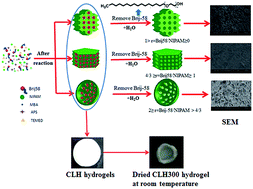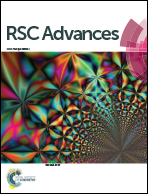Trail of pore shape and temperature-sensitivity of poly(N-isopropylacrylamide) hydrogels before and after removing Brij-58 template and pore formation mechanism†
Abstract
To investigate the change upon structure and temperature-sensitivity of porous hydrogels before and after removing Brij-58 and confirm the pore formation mechanism, a series of hydrogels (abbreviated as CLH) based on N-isopropylacrylamide (NIPAM) serving as functional monomer and polyoxyethylene-20-cetyl-ether (Brij-58) acting as template were obtained. The chemical composition, crystal structure and temperature-sensitivity of PNIPAM hydrogels before and after removing Brij-58 were compared and confirmed by FTIR, XRD and DSC. The optical performance, pore shape and (de)swelling behavior of prepared CLH hydrogels were investigated by UV/vis, SEM and gravimetric method. The disappearance of the characteristic absorption peak at 1062–1146 cm−1 and coincidental absorption peak at 195 nm, and recovery of diffraction peaks at 2θ = 7.8° and 2θ = 20.75° all confirmed that Brij-58 plays a template role and could be removed after 48 h. With increasing mass ratios of Brij-58/NIPAM from 0 to 2, the critical time of optical transmittance of CLH hydrogels dropping to 0 from 100 decreases to 7.5 min from 22 min, while maximum equilibrium swelling ratios increase from 6.3 to 10.31 g g−1. SEM images show that, with increasing mass ratios of Brij-58/NIPAM from 0 to 2, CLH hydrogels first form homogeneous and smaller pores, and then pore sizes increase from 4–10 μm to 50–100 μm together with interconnected pore structure. With increasing mass ratios of Brij-58/NIPAM, thermo-responsibility of CLH hydrogels containing Brij-58 template disappeared gradually and then recovered after removing template. The deswelling rates of CLH hydrogels depend on the mass ratios of Brij-58/NIPAM as r = Brij-58/NIPAM ≤ 1/10, the hydrogels lose over 70% water within 60 min, while the hydrogel loses over 70% water within 10 min as r = Brij-58/NIPAM = 2. This kind of templated hydrogel with adjustable porous structure has much potential in the fields of drug delivery, tissue engineering and chemical separation.


 Please wait while we load your content...
Please wait while we load your content...